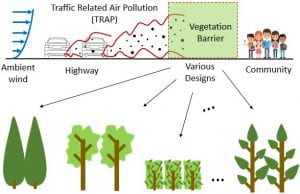Communities located in near-road environments are exposed to traffic-related air pollution (TRAP). While roadside vegetation barriers can help mitigate TRAP, their effectiveness to reduce TRAP is influenced by site-specific conditions requiring testing before implementation. To test vegetation designs using field measurements or high-fidelity numerical simulations is often infeasible since urban planners and local communities often lack the access and expertise to use those tools. There is a need for a fast, reliable, and easy-to-use method to evaluate vegetation barrier designs based on their capacity to mitigate TRAP. In this project, we investigated five machine learning (ML) methods, including random forest (RF), XGBoost (XGB), neural networks (NN), linear regression (LR), and support vector machine (SVM), to predict particle concentrations downwind of various vegetation barrier designs. The ML models developed in this project have been integrated into a webtool that can provide estimates of expected pollutant reduction for various green infrastructure designs in a timely manner helping local communities choose ideal barriers to address their local TRAP problems.
To learn learn more about this project please check our publication!
